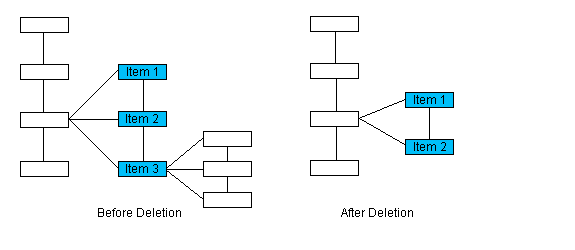DeleteKey Method
public void DeleteKey(DicomElement element)
- (void)deleteKey:(LTDicomElement *)element; public void deleteKey(DicomElement element) public:void DeleteKey(DicomElement^ element)
Parameters
element
The key element to delete.
When a key element is deleted using this method, all offspring of the key element (both key element children and non-key element children) and all their respective children are also deleted. Below are illustrations of this. For the sake of these illustrations, the order of siblings is top to bottom.
Please note that the numbering of the items of interest is arbitrary, and does not imply order.
In this illustration, item 2 will be deleted. If any of the children of item 2 had children, these would be deleted also.

In this illustration, item 3 will be deleted. Again, if any of the children of item 2 had children, these would be deleted also.

Please note that key elements should not be deleted using DeleteElement. Deleting a key element using DeleteElement will not delete any child key elements, but will delete information that references the child key elements.
For more information about key elements, refer to Working with Basic Directory Key Elements.
using Leadtools;using Leadtools.Dicom;public void DicomDIRSample(){//Make sure to initialize the DICOM engine, this needs to be done only onceDicomEngine.Startup();using (DicomDataSet dicomDIR = new DicomDataSet()){dicomDIR.Reset();//Initialize the dataset as a DICOMDIR classdicomDIR.Initialize(DicomClassType.BasicDirectory, DicomDataSetInitializeType.ExplicitVRLittleEndian);Debug.Assert(dicomDIR.InformationClass == DicomClassType.BasicDirectory);Debug.Assert(dicomDIR.InformationFlags == (DicomDataSetFlags.ExplicitVR | DicomDataSetFlags.LittleEndian | DicomDataSetFlags.MetaHeaderPresent));//Insert a patient level keyDicomElement patientKey = dicomDIR.InsertKey(null, DicomDirKeyType.Patient, true);//Insert a study key under the patient keyDicomElement studyKey = dicomDIR.InsertKey(patientKey, DicomDirKeyType.Study, true);//Now insert three series keys under the study keyDicomElement seriesKey = dicomDIR.InsertKey(studyKey, DicomDirKeyType.Series, true);seriesKey = dicomDIR.InsertKey(studyKey, DicomDirKeyType.Series, true);seriesKey = dicomDIR.InsertKey(studyKey, DicomDirKeyType.Series, true);DicomElement key = dicomDIR.GetRootKey(seriesKey);//Get the key value, You can also call GetKeyValuePtrDicomDirKeyType keyValue = dicomDIR.GetKeyValue(key);//The root key for the series key should be patientDebug.Assert(keyValue == DicomDirKeyType.Patient, "The root key for the series key should be patient in this case");//Get the parent key for the series, it should be studykey = dicomDIR.GetParentKey(seriesKey);keyValue = dicomDIR.GetKeyValue(key);Debug.Assert(keyValue == DicomDirKeyType.Study, "The parent key for the series key should be study in this case");//The child for the study key should be serieskey = dicomDIR.GetChildKey(studyKey);keyValue = dicomDIR.GetKeyValue(key);Debug.Assert(keyValue == DicomDirKeyType.Series, "The child for the study key should be series");//The first key should be patient, if we traverse the DICOMDIR as a listkey = dicomDIR.GetFirstKey(studyKey, false);keyValue = dicomDIR.GetKeyValue(key);Debug.Assert(keyValue == DicomDirKeyType.Patient);//The last key should be series, if we traverse the DICOMDIR as a listkey = dicomDIR.GetLastKey(studyKey, false);keyValue = dicomDIR.GetKeyValue(key);Debug.Assert(keyValue == DicomDirKeyType.Series);//The key before the study key should be patient, if we traverse the DICOMDIR as a listkey = dicomDIR.GetPreviousKey(studyKey, false);keyValue = dicomDIR.GetKeyValue(key);Debug.Assert(keyValue == DicomDirKeyType.Patient);//The key after the study key should be series, if we traverse the DICOMDIR as a listkey = dicomDIR.GetNextKey(studyKey, false);keyValue = dicomDIR.GetKeyValue(key);Debug.Assert(keyValue == DicomDirKeyType.Series);//If we delete the study key, the series keys under it will get deleted toodicomDIR.DeleteKey(studyKey);key = dicomDIR.FindFirstKey(null, DicomDirKeyType.Series, false);Debug.Assert(key == null);key = dicomDIR.FindLastKey(null, DicomDirKeyType.Series, false);Debug.Assert(key == null);key = dicomDIR.FindPreviousKey(null, false);Debug.Assert(key == null);key = dicomDIR.FindNextKey(null, false);Debug.Assert(key == null);}DicomEngine.Shutdown();}
Reference
© 1991-2023 LEAD Technologies, Inc. All Rights Reserved.
